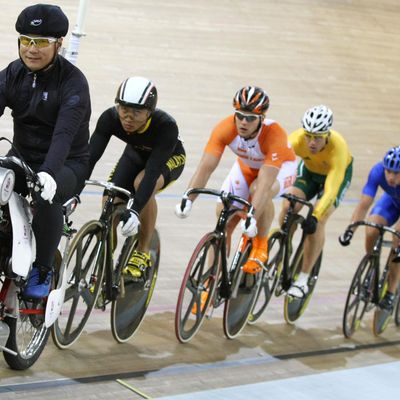
The last time motorized competition was included in the Olympics was the London games of 1908: Motorboat races were contested in three size classifications, though only gold medals were awarded — a storm knocked out all but one boat in each race. The organizers of the games decided after the fact that motors were not in the spirit of Olympic competition. But motors are still a big part of at least one sport: The track cycling event of keirin uses a motorcycle to pace a line of cyclists up to high speeds before pulling off and letting the riders sprint to the line. The sport was invented in the late forties in Japan, and horse-race-style gambling on races has become big business there. Keirin has been an Olympic event since 2000. Here’s how it works.
Event Format
Both the men’s event and the women’s event are structured the same way: Eighteen riders compete, and only one rider per nation may qualify. Each race has six riders. There are three races in the first round, and the top two riders from each race advance. In a round called the “first round repechage,” the remaining riders contest two races with the top three riders advancing, leaving twelve riders total in the second round. Those riders contest two races with the top three riders advancing to the final. Medals are awarded according to finishing order in the final.
Competition Area
International keirin races are held in indoor velodromes, with 250-meter oval wooden tracks with extremely steeply banked corners. Two lines running the distance of the track are important in keirin: A black line 20 centimeters from the bottom marks the official measured distance of the track, and a red line 90 centimeters above that indicates the “sprinters lane.” Riders in this narrow strip may not be overtaken on the inside. A wide blue stripe on the inside of the track acts as a sort of out of bounds: It’s up to the judges to determine if a rider gained an advantage by riding on it, but it’s not an immediate violation. There is no out of bounds on the top of the track.
Equipment
The cyclists ride track bicycles that have no brakes, no gears, and do not allow the rider to coast, the functional ancestor to the “fixie” locked up outside your local trendy coffee shop. The bikes are designed to reduce aerodynamic drag: They have very low handlebars and sport sleek carbon fiber wheels that look more like ceiling fans and solid disks than traditional wire-spoke wheels. The rest of the rider’s equipment is also designed with aerodynamics in mind: Sleek helmets with full face visor and tight spandex “skinsuits” are the norm. The pacing motorcycle, called a “derny,” is a motor-assisted bicycle that can easily achieve the required speeds and is ridden by a neutral track official.
How Someone Wins
The six riders are held by coaches at the start line. The derny starts from behind them and, once it passes, the signal is given to start. After an initial jockey for position, the riders form a line behind the derny to take advantage of its aerodynamic draft. Over the next five and a half laps, the derny slowly builds from about 16 to more than 30 miles per hour and pulls off with two and a half laps (750 meters) to go. No rider may overtake the rear wheel of the derny, and the aerodynamic assistance provides a strong incentive to stay in a line, but once it pulls off, the riders fan across the track and race for the finish in an all-out sprint. The winner of the race is the first rider across the line; finishing speeds are typically in excess of 40 miles per hour. The race lasts about two minutes in total; the sprint lasts about 40 seconds.
When to Watch
The women’s keirin was on Friday, August 3; a replay is available on nbcolympics.com. The men’s event is tomorrow, August 7. The first round will begin at 5 a.m. and will stream live on nbcolympics.com. The races will also be broadcast live from 11:30 to 11:45 a.m. and from 1 to 1:15 on NBC in New York (though the schedule of the local affiliate could potentially differ in other markets).
Previously:
The Casual Olympic Viewer’s Guide: Trampoline
The Casual Olympic Viewer’s Guide: Dressage
The Casual Olympic Viewer’s Guide: Double Trap Shooting